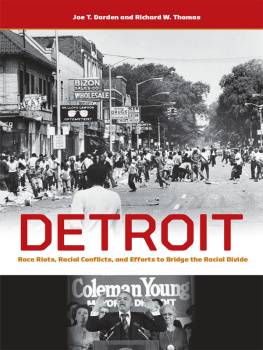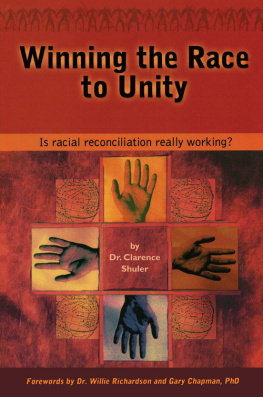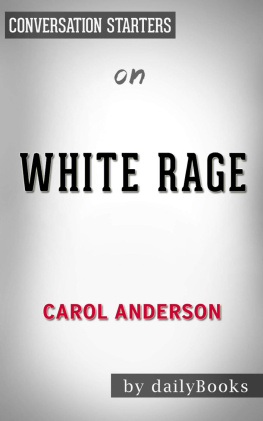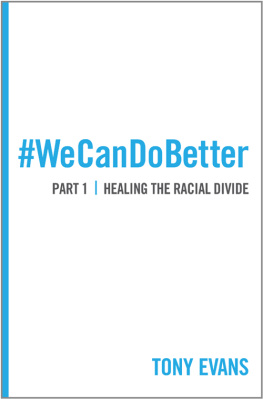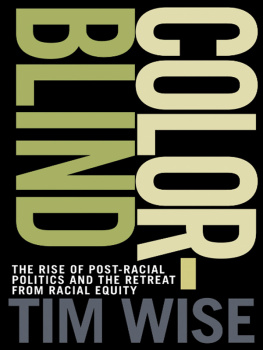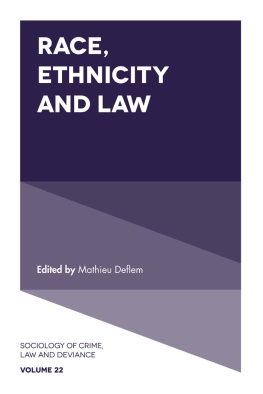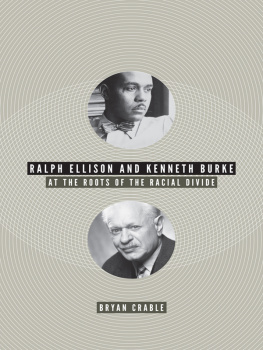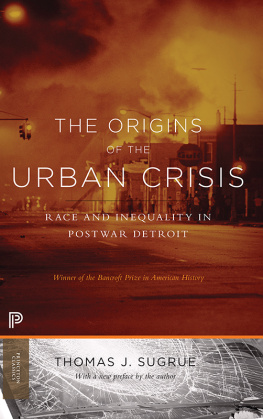Joe T. Darden - Detroit: Race Riots, Racial Conflicts, and Efforts to Bridge the Racial Divide
Here you can read online Joe T. Darden - Detroit: Race Riots, Racial Conflicts, and Efforts to Bridge the Racial Divide full text of the book (entire story) in english for free. Download pdf and epub, get meaning, cover and reviews about this ebook. publisher: Michigan State University Press, genre: Politics. Description of the work, (preface) as well as reviews are available. Best literature library LitArk.com created for fans of good reading and offers a wide selection of genres:
Romance novel
Science fiction
Adventure
Detective
Science
History
Home and family
Prose
Art
Politics
Computer
Non-fiction
Religion
Business
Children
Humor
Choose a favorite category and find really read worthwhile books. Enjoy immersion in the world of imagination, feel the emotions of the characters or learn something new for yourself, make an fascinating discovery.
- Book:Detroit: Race Riots, Racial Conflicts, and Efforts to Bridge the Racial Divide
- Author:
- Publisher:Michigan State University Press
- Genre:
- Rating:3 / 5
- Favourites:Add to favourites
- Your mark:
- 60
- 1
- 2
- 3
- 4
- 5
Detroit: Race Riots, Racial Conflicts, and Efforts to Bridge the Racial Divide: summary, description and annotation
We offer to read an annotation, description, summary or preface (depends on what the author of the book "Detroit: Race Riots, Racial Conflicts, and Efforts to Bridge the Racial Divide" wrote himself). If you haven't found the necessary information about the book — write in the comments, we will try to find it.
Joe T. Darden: author's other books
Who wrote Detroit: Race Riots, Racial Conflicts, and Efforts to Bridge the Racial Divide? Find out the surname, the name of the author of the book and a list of all author's works by series.
Detroit: Race Riots, Racial Conflicts, and Efforts to Bridge the Racial Divide — read online for free the complete book (whole text) full work
Below is the text of the book, divided by pages. System saving the place of the last page read, allows you to conveniently read the book "Detroit: Race Riots, Racial Conflicts, and Efforts to Bridge the Racial Divide" online for free, without having to search again every time where you left off. Put a bookmark, and you can go to the page where you finished reading at any time.
Font size:
Interval:
Bookmark:

Copyright 2013 by Michigan State University
 The paper used in this publication meets the minimum requirements of ANSI/NISO Z39.48-1992 (R 1997) (Permanence of Paper).
The paper used in this publication meets the minimum requirements of ANSI/NISO Z39.48-1992 (R 1997) (Permanence of Paper).

Michigan State University Press
East Lansing, Michigan 48823-5245
Printed and bound in the United States of America.
19 18 17 16 15 14 13 1 2 3 4 5 6 7 8 9 10
LIBRARY OF CONGRESS CATALOGING-IN-PUBLICATION DATA
Darden, Joe T.
Detroit : race riots, racial conflicts, and efforts to bridge the racial divide / Joe T. Darden and Richard W. Thomas.
p. cm.
Includes bibliographical references and index.
ISBN 978-1-60917-352-4 (ebook)ISBN 978-1-61186-066-5 (pbk. : alk. paper)
1. Detroit (Mich.)Race relationsHistory20th century. 2. Race riotsMichiganDetroitHistory20th century. 3. ViolenceMichiganDetroitHistory20th century. 4. African AmericansMichiganDetroitHistory20th century. I. Thomas, Richard Walter, 1939 II. Title.
F574.D49N43345 2013
305.896'073077434dc23 2012028156
Book design by Scribe Inc. (www.scribenet.com)
Cover design by Charlie Sharp of Sharp Des!gns, Lansing, MI.
Front cover photo is of Detroit, Michigan, 24 July 1967, as 12th Street descends into chaos on the first day of civil unrest. At rear, center, the Blind Pig, whose raid by police officers sparked the conflict, can be seen behind the Economy Printing sign. In the distance a photographer snaps pictures of the scene. Detroit News Collection #318; Walter P. Reuther Library, Wayne State University. Front cover inset photo is of Mayor Coleman A. Young, as a candidate for reelection in 1977, on election night with Gladys Whitt and Joyce Garrett, 8 November 1977, Detroit News Collection #2995; Walter P. Reuther Library, Wayne State University.
Back cover photographs are of the Focus: HOPE Walk 2008, used courtesy of Focus: HOPE and Detroit Public Library Special Collections; and of the Michigan Roundtable for Diversity Youth Summit, used courtesy of Michigan Roundtable for Diversity and Inclusion.

Michigan State University Press is a member of the Green Press Initiative and is committed to developing and encouraging ecologically responsible publishing practices. For more information about the Green Press Initiative and the use of recycled paper in book publishing, please visit www.greenpressinitiative.org.
Visit Michigan State University Press at www.msupress.org
This book is dedicated to the people and organizations in the city of Detroit, the suburbs, and beyond who have contributed to the struggle to bridge the racial divide since the riot of 1967.
THIS BOOK WAS MADE POSSIBLE BY THE CONTRIBUTIONS OF OTHERS. THUS, WE OWE them our sincere appreciation. Lisa Eldred provided outstanding editorial assistance for the entire manuscript. We also received assistance in bibliographic collections and data gathering from Kayla Benard, a recent graduate from Michigan State University. We appreciate her contribution. We also owe a great debt of gratitude to Andy Lee, a former graduate assistant in the Urban Affairs Program at Michigan State University, for researching newspaper accounts covering the Vincent Chin case and collecting materials from the American Citizens for Justice (ACJ) upon which is based. We also appreciate the assistance that the ACJ provided to Andy during his work on the project. Thanks also to Alexis Braun Marks, archivist at the Charles H. Wright Museum Archives Library, who came to our aid when we desperately needed to access the archives' collection of Mayor Coleman Young's papers. Thanks to Thomas Costello, Jr., President of the Michigan Roundtable for Diversity and Inclusion, and Matt Hoerauf, Community Development Manager of the Michigan Roundtable for Diversity and Inclusion, for their cooperation in gaining us access to the organization's papers and documents. We also thank the staffs of the Bentley Historical Library at the University of Michigan and other collections. Finally, we want to thank Julie Loehr, assistant director of Michigan State University Press, for understanding the need for such a volume as part of the MSU Press collection.
DURING THE SUMMER OF 1967, DETROIT, MICHIGAN'S LARGEST CITY, EXPERIENCED the worst race riot in the city's history and the most severe racial conflict in the entire nation. During a two-week period, which began on July 23, at least 43 people were killed, hundreds were wounded, and numerous properties were destroyed. This urban disorder would influence racial thinking and the collective memories of blacks and whites throughout the coming decades. This book examines six basic questions. What happened? Where did it happen? Why did it happen? To what extent have the conditions that caused the riots changed since the riots? What efforts have occurred since the riots to reduce racial conflicts and build bridges across racial divides? What are the alternative futures for Detroit residents?
The ideas expressed in the book are grounded in the following themes: Place of residence matters. Spatial injustice has been a recurring problem, and a remedy worth exploring is the geography of opportunity. The book is based on a comprehensive set of data sources, both primary and secondary. It draws heavily from U.S. census reports and archival documents. The Detroit riots are examined within the contexts of two landmark governmental reports by presidential commissions that focused on race: Report of the National Advisory Commission on Civil Disorders (the Kerner Commission Report), published in 1968, and One America in the 21st Century: Forging a New Future, also called the John Hope Franklin Report. Both reports were initiated under Democratic administrations, and most black Detroiters have consistently been supportive of the Democratic Party.
Our socioeconomic analysis, which revealed inequality by race and place, led to a key political question: what do these two reports and our own data and analyses tell us about the effectiveness of black political leadership in Detroit in reducing racial divides? What do the results tell us about a black politically controlled city's ability to improve the lives of the predominantly black residents? In other words, what has been the effectiveness of black political power and black demographic dominance in driving socioeconomic change in Detroit?
The spark that set off the riots in Detroit was actions by the predominantly white police toward members of the black community. This book examines the relationship between the black community in Detroit and the police. The volume also examines black-white inequality and conflict in the public schools, employment and unemployment, housing, and the sharing of neighborhoods. However, racial conflict in Detroit extends beyond just blacks and whites. Thus, this volume examines Asian-white conflict, black-Arab conflict, and black-Latino conflict. The book examines organized efforts over the years to reduce the many conflicts and bridge racial divides.
The final chapter offers alternative futures for residents of Detroit. Among the alternatives is a spatial mobility strategy within the context of a geography of opportunity for those residents who want to move to greater economic and social opportunities that lie beyond the city's borders.
As members of the team of researchers who examined the racial divide in Detroit in the volume
Font size:
Interval:
Bookmark:
Similar books «Detroit: Race Riots, Racial Conflicts, and Efforts to Bridge the Racial Divide»
Look at similar books to Detroit: Race Riots, Racial Conflicts, and Efforts to Bridge the Racial Divide. We have selected literature similar in name and meaning in the hope of providing readers with more options to find new, interesting, not yet read works.
Discussion, reviews of the book Detroit: Race Riots, Racial Conflicts, and Efforts to Bridge the Racial Divide and just readers' own opinions. Leave your comments, write what you think about the work, its meaning or the main characters. Specify what exactly you liked and what you didn't like, and why you think so.

